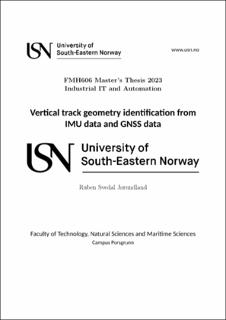Vertical track geometry identification from IMU data and GNSS data
Master thesis
Permanent lenke
https://hdl.handle.net/11250/3072520Utgivelsesdato
2023Metadata
Vis full innførselSammendrag
This report presents a study on predicting the elevation of a stretch of railroad track using a combination of sensors, data processing techniques, and algorithms. Initially, the research aimed to utilize both an IMU sensor and a GNSS sensor. However, due to noise and filtering issues in the IMU data, the study focused solely on the GNSS sensor. The investigation involved preprocessing the data, addressing uncertainties in the dataset, and generating clothoid splines to fit the data accurately. Two algorithms, RANSAC and Monte Carlo, were explored for generating clothoids. The simpler RANSAC algorithm combined with optimization achieved the best results, consistently yielding an RMSE below 0.2 meters.
The performance of the solution is primarily dependent on the quality of the input data and its alignment with the actual elevation values. Challenges faced in the study, such as the distribution of points in the clothoid generation process and the lack of a reliable reference for validating the dataset, indicate potential areas for improvement in future research. In summary, the report demonstrates the feasibility of accurately predicting railroad track elevation using sensors and data processing techniques, while also highlighting the need for further investigation to address the identified limitations and uncertainties. The University of South-Eastern Norway accepts no responsibility for the results and conclusions presented in this report.
